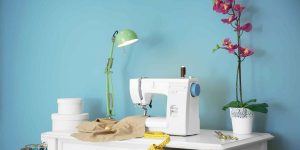My Juki DDL-8700-H review is dedicated to this rather popular and interesting model. I plan to test it as usual and tell you about its features and characteristics. With a focus on speed and precision, especially with heavier fabric types designed by Juki, one of the leading names in sewing technology. Whether you are a professional tailor or an amateur enthusiast, getting to know the potential and limitations of your tools is important. Let’s take a closer look at the capabilities of the Juki DDL-8700 H, which has received many positive reviews for its durability and efficiency when sewing heavy fabrics.
Build and design

Throughout my experience of working with the Juki DDL-8700-H sewing machine, its construction and design never ceased to amaze me. Metal, which is the machine’s main material of construction, not only guarantees durability but also provides it. Despite heavy utilization, the machine is only slightly worn out to prove that, indeed, high-quality materials were used in its construction. The careful positioning of plastic components is a nice detail, which makes the machine less awkward than you would imagine without compromising its durability. As for myself, I’ve been impressed by its pragmatic simplicity, which has no fluff and is focused entirely on functionality. The integrated bobbin winder and easy-reach stitch length adjustment dial are not just design features but the result of thoughtful consideration of the user’s workflow, streamlining processes that save time.
Key features and performance
The benefits of the Juki DDL-8700-H are far more significant than its weaknesses. The machine’s rugged construction and the way it can provide accurately consistent stitches, even when processing difficult materials, have made my professional toolkit redundant without this implementation. In a very literal sense, the reverse stitch lever and semi-automatic needle threader aren’t just convenient; they are game changers that will dramatically cut down on time and effort when working on complicated projects.
However, one should have some realistic expectations when dealing with this machine. For a broad set of decorative stitches needed in your work, the variety available might seem somewhat restricted. In some of my projects, it has been a minor problem. Additionally, although the operational noise is granted to be lower than that of other industrial machines, it remains perceptible – something I’ve noticed in my quiet studio at night while working.
Despite these differences, my work relationship with the Juki DDL-8700-H has been mostly smooth. Unbalancing tension, alternating stitch lengths, or handling hefty fabrics are some things this machine does without a fuss; it is further evidence to attest to its design and build quality.
What’s in the box

- The Juki DDL-8700-H machine head
- A complete table assembly
- A sewing machine drawer
- A bobbin winder
- Machine oil
- Instruction manual
Pros and cons
- A solid metal structure provides durability in the long run.
- Performed well when sewing heavy fabrics.
- Semi-automatic needle threader and reverse stitch lever for better functionality.
- It has more emphasis on the standard stitches and provides fewer decorative features.
- It’s not the quietest machine you can find on the market.
Key specs
- Built-in stitches: 32.
- Maximum stitch width: 5mm.
- Stitch selection: dials.
- Drop feed: yes.
- Free arm: yes.
- Foot pressure: yes.
- Size, inches/cm: 7.8×7.5×3.9/19.8x19x9.9.
- Weight, lbs/kg: 70/31.7.


![The 4 Best Machines Under $500 [Budget Sewing Solutions]](https://www.favoritethings.net/wp-content/uploads/2024/03/best-sewing-machine-under-500-review-300x150.jpg)

![Best Sewing Machines for Upholstery [Crafting with Quality]](https://www.favoritethings.net/wp-content/uploads/2024/02/best-sewing-machine-for-upholstery-300x150.jpg)










